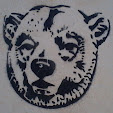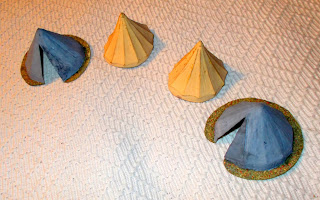The inner pair is undecorated, latex
rubber; the outer pair is from the later vac-formed polystyrene-sheet which
also contained a set of pup-tents (so crude I threw them away I think, or were
they on another sheet?) and a more medieval-looking marquee or staff tent. I opened the 'doorways' with a sharp knife!
Holding the slight squeeze out of them, by
counter-squeezing; when I obtained these about eleven-years ago (one of Andy
Harfield's shows down in Kent I think) they were pretty-much pristine, and
remained-so when they went into storage in 2011
However they have suffered slightly from
the conditions in the shipping container, getting slight blemishes of shiny
perished latex where they were touching each-other and the holding bag (that
squeezed them out of shape slightly), yet otherwise they are still flexible and
will need to be painted in the near future to protect them further, finding a
paint for latex, or that is latex safe might need to be a consideration?
The more interesting thing about these
latex items is that while they conform to the later vac-forms in both shape and
catalogue codes, they are otherwise very different items, however, the one
clearly lead to the other.
Above - not the best image (I've stopped-it
right down), but the best I could do (try tipping your screen back slightly, or dipping your head, to
see the vac-form's marks clearer), you can see how the three lines and the
arrowed dink/blemish are carried on to the underside of the vac-form, from the
surface of the latex moulding
The vac form has - like all these large
sheet vac-forms - the better detail on the underside, as it is pulled onto the
mould by suction, but that detail matches the finer detail on the surface of
the smaller latex mould, as if it had been removed from the vac-form.
But it's not as clear as someone taking
latex moulds from Bellona vac-forms
and passing them off as Bellona (the
cynical- or suspicions-thinking behind my original comment on Clive's post), because there is extra detail on the rubber
versions; with these tents it's the air-flap 'barb' at the apex of the bell,
and the overhang between bell and skirt-sides.
Likewise on the cottages over at Clive's blog,
you can see the dormer windows on the rubber versions have an overhang to the roof
which were smoothed back on the vac-forms. These features had to be removed from
the tool/moulding to allow for the release of the vac-form, after cooling; a
similar problem for the tooling engineers to that of 'undercuts' on dynamically
posed figures.
How the one became the other is only to be
guessed at, but must have involved taking a more substantial moulding from the
tent's tool, to get a solid lump resembling the hollow latex product, removing
all the overhangs, joining them together with the other tents on a level
'sheet', taking another, negative mould of that, and producing the metal
final-tool as a third [positive] from the second [negative]? .. . . . . ... . . I think!
As an aside; there is a 12-panel 1930-50's
British army bell-tent in the attic, my brother and I would spend a few weeks
in it each summer, as kids. I keep meaning to get it out and set it up to see
if the moths have been kind to it . . . or not.
It's interesting in being fully reversible,
white on one side for winter-warfare and a non-standard camouflage on the
other. By non-standard I mean it's not a WWII Micky-mouse black/grey cloud on
green, nor sweeping swathes of contrasting colours, not a Denison smock type,
nor a 1970's DPM, and will I suspect (I'm sure there are various labels on it
and its canvas carry-all) date from either the inter-war period or the Korea
era?
But it is a dead ringer for Bellona's little beauty, even to the
air-flaps creating a spear's-head at the top if it's breezy!
--------------------------------------------
Here's one I made earlier!
As a Brucey-bonus, I knocked this up from a
piece of cartridge-paper years ago, then added some slivers of weathered
plywood for poles and coloured-it-in with art-markers. I think the 'eyes' were Tippex and another - green - marker!
If I did it again I'd run the poles all the
way down and make them from something stronger as they have mostly broken-off
and the smoke-hole now looks like Hannibal Lectors' mask! I'd probably also wet
the paper after shaping to produce some sag between the poles; colouring-in
after it had dried?
I took the pattern from something
commercial like Fiddler's Green or Usbourn, or even a cut-out freebee in White Dwarf? It's basically a cone with
the tip cut-off and it's a bit too geometric!







No comments:
Post a Comment